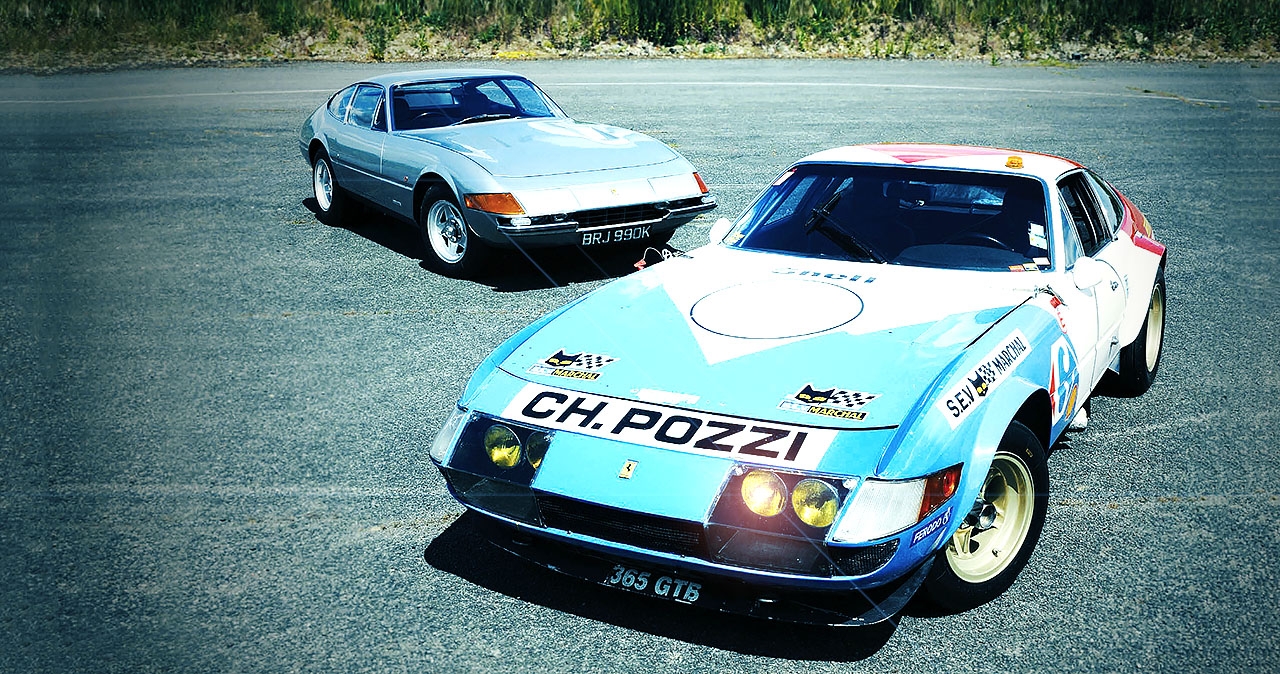
Ferrari 365 GTB/C – the glorious competition Daytonas Power and Glory. Enzo Ferrari did not consider that the big Daytona had racing potential, but the dealer teams and customers thought otherwise Story by Phil Ward, Roberto Giordanelli, Richard Heseltine and Keith Bluemel. Photography by Michael Ward.
We have written about the competition Daytonas before, in particular the Pozzi France car Ch. 15667. Roberto Giordanelli drove it at Silverstone back in 2005 and I have included an extract from his test drive for readers who missed it first time round. I make no apology for running another feature on 15667 as I had first hand experience of the car recently. I have also included comments from five times Le Mans winner Derek Bell who raced a sister Daytona at Le Mans in 1972.
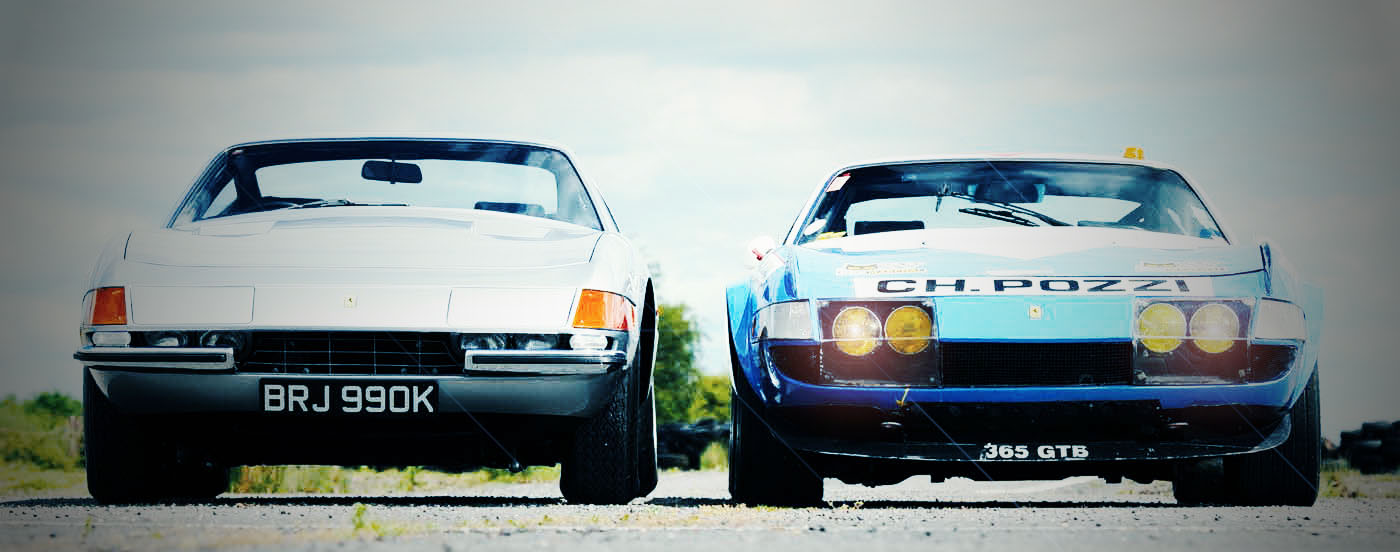
Daytona Ch. 15667 is a series 2 CAD (Customer Assistance Department) car and ran at Le Mans in 1972 carrying race number 39. Driven by Andruet, Lena and Migault it achieved 297km/h (186mph) on the Mulsanne straight. The team finished 5th overall and 1st in class and the car went on to win the Tour de France in the same year. It returned to Le Mans in 1973 taking ninth place to become the most successful of all racing Daytonas.
My first encounter with the ‘Pozzi Daytona’ was back in 1997 when this magazine was just two years old. The car had been acquired by Talacrest in 1997 when it was sold by Francois Domet, having been in his family since its last race in 1973 run by the Charles Pozzi France team. The current owner has kept the car since 1997, making it a very rare three owner competition Daytona. It has been raced extensively in historic events and has been largely unrestored, maintaining its delightful well used appearance.
The current owner has a large collection of cars and to complement the competition car he also has a standard road car. Both cars are expertly maintained by Ian Barkaway, so when the opportunity arose for us to drive both cars I was confident that they would work properly. It is a fact that many restoration queens don’t go as well as they look, and some speculative buyers never drive them anyway. The owner of these two Daytonas is very much a hands on driver and puts considerable effort into their preparation.
BELOW: Of the 15 client Daytonas Ch. 15667 has the most significant results with a 5th at Le Mans and 1st in the Tour de France.
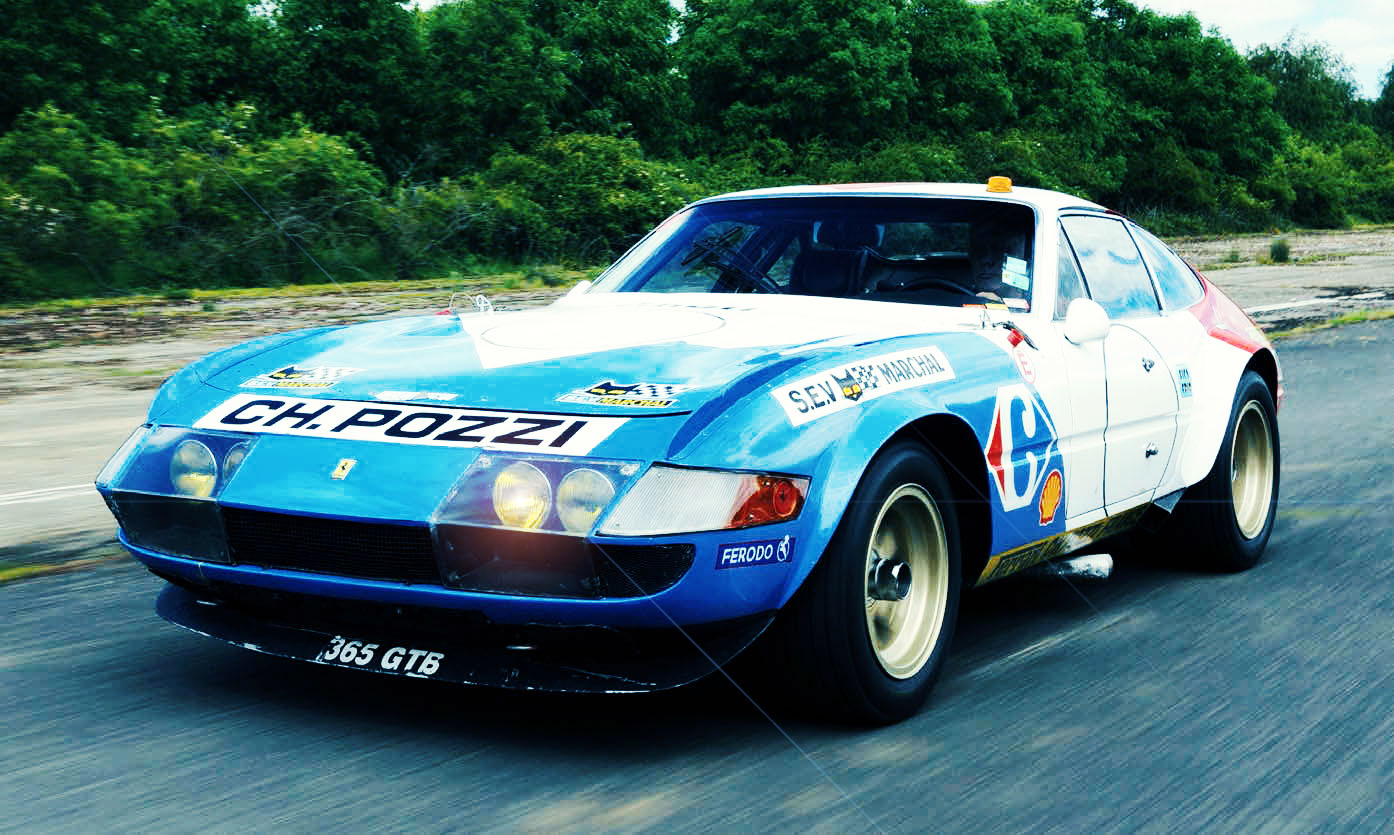
We collected the cars from their exclusive storage facility at Maxted-Page near Halstead in Essex and were allowed to drive them to our airfield location. While the production car was perhaps not such an unusual sight in this sleepy part of Essex, the competition car certainly was. It is road registered, with the highly appropriate number 365 GTB, which it has to be since it is driven on road events like the Tour de France and Cento Ore. Nevertheless, piloting a full blown historic racing car down Halstead High Street was a surreal experience, not just for me but members of the public. Even at low revs the Daytona was making an extraordinary racket, the noise bouncing off the shop windows and setting off car alarms. People stopped going about their daily business and the mobile phones came out to record the scene. Not everyone was impressed as one woman steadfastly ignored the red, white and blue machine, shaking her head in disapproval.

ABOVE: The current owner obtained the car from Talacrest in 1997 and has raced it regularly ever since.
The Daytona’s fuel gauge was not working, though the fuel pressure gauge was. I’ve never understood the relevance of a pressure gauge, surely if the pressure begins to drop then you are running out of fuel, not a good sign if you are bellowing past the grandstand at Le Mans with a full lap to go. Maxted-Page advised me that they had put some fuel in the tank but I decided to top it up anyway since running out on the public road would not be good form and hazardous to say the least. So, there we were, a full blown Le Mans Daytona parked at a local filling station with me struggling to get the nozzle past the flap on the Le Mans fast filler on the cavernous tank.

The tank suitably refreshed, I gingerly negotiated the rest of the High Street and the open road beckoned where I was able to open up the Daytona. Memories of driving the 500 Mondial on the Mille Miglia flooded back. To make the Daytona work properly I needed to be positive with the controls, double-declutching up the box as well as down. Roaring down country lanes is not what this car was designed for and there were few opportunities to really open it up, there were no Mulsanne-type straights in this part of Essex. When I did find some decent road the acceleration was relentless with the big engine sounding magnificent.

We swapped cars for the return journey and the difference in behaviour was enormous. The silver roadcar just wafted along, the springing was quite soft with some bodyroll in the corners. This is not a car for hurtling around country lanes it is very much a long legged GT car, its big, lazy engine and plush interior ideal for those long drives down to the Riviera. There’s no wonder that Enzo didn’t believe that the Daytona could be turned into a competition car. Fortunately for us his dealers and their customers persuaded him otherwise.
SILVERSTONE TRACK TEST BY ROBERTO GIORDANELLI
Auto Italia’s Editor and I are waiting in the cold. It’s a grey test day in a grey month at a grey Silverstone. A tow truck trundles away to excavate a beached racer from the Silverstone gravel. All is as quiet as a fall of snow. “I can hear a Ferrari,” says the Editor. The distant sound waves dance. The Le Mans Daytona is in two places at once; minutes away in time and distance, but in spirit it is already in the paddock. Eventually it rumbles over the bridge, breaking up the ambient monochrome, resplendent in its red, white and blue patina. It stops at our feet. Racer and engineer Gary Pearson switches off the 12 cylinders and creates that weird sensation that everyone who has been in a race paddock recognises. That shocking, bouncing silence you get when a 120db race engine suddenly cuts is difficult to explain, but you know what I mean.
As historically significant as a car can get, ‘Pozzi’ Daytona Ch. 15667 belongs to racer and collector Carlos Monteverde. With the test session starting, I receive a short briefing: “That’s the ignition switch and that’s the starter button.” The Daytona starts, idles and trembles the tarmac. The slightest touch of the accelerator sends the revs through the roof. Knowing that throttle response at idle is directly proportional to power, I realise I’m in for a wild ride. Never has the loud pedal been so aptly named. With zero silencing, 12 primary exhaust tubes become four big megaphone side-pipes.
Still in Tour Auto spec, the Daytona rumbles down the pit lane and shakes the buildings. For events like the five-day Tour Auto, headphones are a must. With wet Silverstone tarmac rapidly unrolling before me, I’m glad of the modern, semi-race, low-profile Michelins (TB15: front 23/62R15, rear 29/61R15) although the Daytona does look better with its original arch-filling Dunlops. Arriving at Becketts – my first corner on the National Circuit – I go for the brake pedal but someone has jammed a house brick underneath it. Or so it feels. Sailing past the unattainable apex, I take a wide line and wait until the 450 horses are pointing in a straight line before unleashing them for the first time down the Club Straight. The rear end squats, the vast alloy bonnet rises, the noise is simply indescribable and 1200kg of Maranello magic does a disappearing act – but not for me as I’m strapped inside the bellowing beast.
At this point I have to say that I am a little worried. Even though I am powering in a dead straight line, I question the grip. There is so much torque that I wonder if the Michelins might light up on the wet track. No problem to correct at low speed but now I’m tanking on in fourth and fifth in a car that looks down on 150mph with distain. The faster you go the less likely you are to recover from a straight line loss of control. If you don’t believe me, go down a motorway at 100mph and crank on an armful of lock. Instead of breaking traction the Daytona swallows the Club Straight, blasting past a Lola Mk1 sports-racer. The plucky pilot is ‘Ferrarista’ Chris Rea.
No other car sounds like a racing Daytona. Real power arrives at 4000rpm. Always deafening, from 5000-8000rpm all your body hair stands on end. The left-right of Brooklands and Luffield are looming fast. This is not a good car in which to lose concentration and miss a braking point. I brake early to avoid the ‘house brick’ feeling – a feeling that improves with pad temperature as they warm the four vented discs. Aware that everyone for miles around can study the gearchanges, the noise that the Daytona makes when blipping on downchanges leaves no place to hide if you get it wrong.
Daytonas don’t like tight turns. Isaac Newton knew this when he wrote his first law of motion: ‘Big heavy things going fast aren’t enthusiastic about change.’ Or something. Daytonas became racing cars by an accident of rule changes, the enthusiasm of the concessionaires and because they are just so bloody butch. All wrong for racing but sheer brute force and strength won the day, especially on long-distance races. Brute force that now wants to attack the distant grandstand rather than slither around Brooklands Corner.
The track surface is too slippery to load up this fabulous racer’s suspension even in its softest and most compliant setting. Handling characteristics are determined by driver inputs – in too fast and it understeers. At parking speeds the unassisted steering is impossibly heavy; on the move it is light, quick and communication is detailed. The more the beast grips, the heavier the steering gets. As grip decays with understeer, so the steering lightens up to warn you to ease off the power. This drops the nose and grip returns. With small-diameter Michelins, gearing is shorter, instantly punching the raucous icon from corner to corner. At any time in the turns, power oversteer is available, oh yes, anytime. Care is needed as despite the front engine, there is a rear transaxle and a good 50% of the car’s mass over the rear end to give surprisingly good traction, much better than I was expecting. Tailslides last a split second longer than with a normal front-engined car.
Woodcote arrives; normally taken flat in the dry, with the nose up and the driver lifting his head, peering for the apex. In the damp it’s another story. Feed in too much power too soon and you will be the most upmarket pinball wizard to ricochet between the concrete walls that line the pit straight. After a few laps I get cocky; teasing the brute and wagging its tail. With the job done and the performance over, the Daytona exits the Silverstone arena and silence returns.
When you drive a pukka lightweight racing car you wonder why anyone bothers with heavy productionbased cars. Driving the heavy Daytona should reinforce this belief but it doesn’t. There is a different sense of satisfaction. The difference you get between training a little circus dog to jump through a hoop compared with that of putting your head into the mouth of a roaring lion. With immense fulfilment, the Editor and I leave a Silverstone that somehow no longer seems so grey.
INTERVIEW WITH DEREK BELL BY RICHARD HESELTINE
“Up to this point the car had been handling like a wayward shopping trolley”
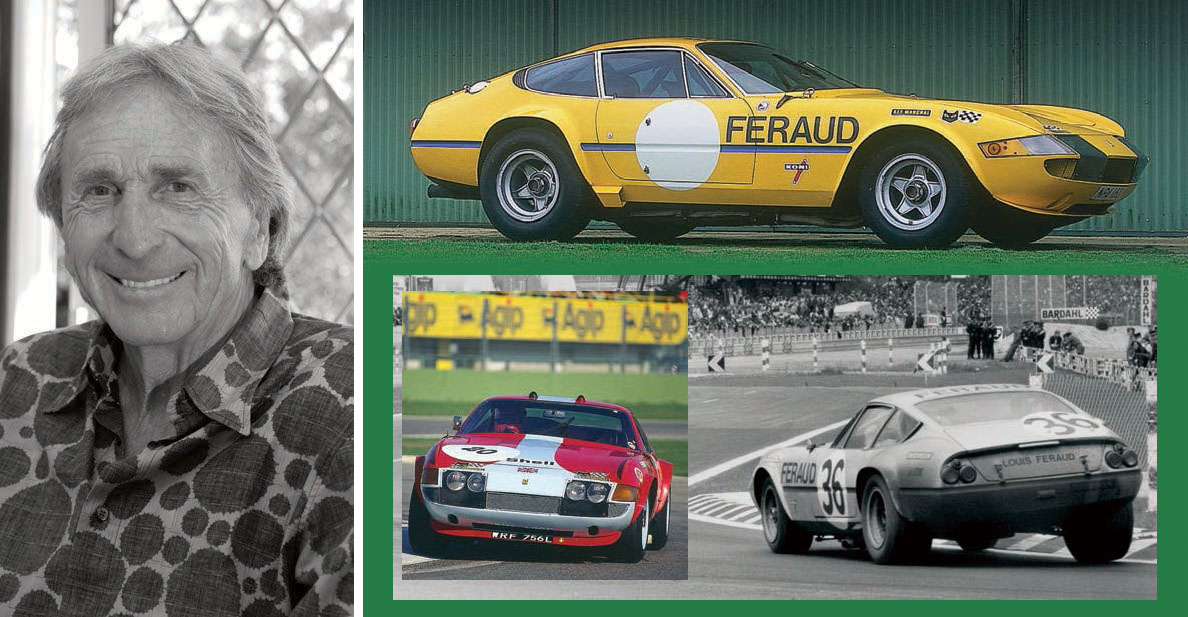
ABOVE: Derek Bell drove car 36 (Ch. 15373) to 8th place at Le Mans in 1972 INSET: The Maranello car (Ch. 15681) was the only Daytona DNF in 1972
“The Le Mans 24 Hours was a race that I came to love, but in the early days I thought it was a bit of a chore. I suppose I still thought of myself as a Formula One driver rather than a sportscar man. Not only that, there was also a world of difference between running at the front in a sports-prototype, and driving mid-pack in a GT car. This was brought home to me in 1972 when I competed aboard a Daytona.
“I was driving for the JW Gulf team in major endurance events, and that year we were developing the Cosworth DFV-powered Mirages. They didn’t run at the 24 Hours in the belief that the cars’ V8s wouldn’t go the distance. They were designed to last the length of a Grand Prix after all. Ferrari, too, withdrew for much the same reason. I was short on drives as the new Sports Car formula was in its infancy, but my old mate Jacques Swaters offered me a drive in his Ecurie Francorchamps Group 4 Ferrari. I would share with Teddy Pilette and gentleman driver Richard ‘Bondini’ Bond. We would be up against a number of Daytonas, but you have to remember that there was considerable divergence between them. Not all of them were legal! “Truth be told, it was a rather nondescript race for us. As I recall, we were lying inside the top ten towards the end of the race, fourth in class, when I was collared by a particularly animated Ferrari man. He pushed me up against some tyres and told me not to challenge Mike Parkes who was running third in class in another Daytona, but I wanted to race so I did!
“Up to this point, our car had been handling like a wayward shopping trolley, but it began to rain in the closing stages so I decided to go for it. Jacques was a bit apprehensive as he didn’t want me to take unnecessary risks, but I got my head down and got right onto Parkes’ tail on the final lap. Going down the Mulsanne straight, I figured I could slipstream past him and out-brake him into the tight corner at the end, even though my car was wallowing all over place. I thought I had it all worked out, had it timed to perfection. However, as I lined up to get into the right place, I was baulked by a slower car going through the kink. What really did for me, though, were the marshals who were on the track waving their flags to celebrate the winner while the rest of us hadn’t completed the lap. We were still racing so it wasn’t terribly clever. It was only later that the mechanics found that the rear anti-roll bar had been broken for much of the race, which explained why it handled so appallingly.
“My abiding memory of the race, though, is what happened afterwards. I had a Daytona as my road car at the time. It was a magnificent gran turismo and, shortly after the end of the race, my then wife and I set off for our hotel. After a while, a voice quietly piped up from the passenger seat: ‘I think you’re going a little too quickly, Derek’. I looked down at the speedo and she was right: it was showing 160mph. I was in the same driving position I had been in for much of the past 24 hours, and I was using the same ’box. I was still in racer mode, with adrenaline coursing through my veins and hadn’t taken on-board the switch from road to racing car!”
FERRARI 365 GTB/4 IN DETAIL BY KEITH BLUEMEL
The 365 GTB/4 berlinetta was the replacement for the 275 GTB/4 in 1968, and like so many new Ferrari models of the period, made its public debut at the Paris Salon. It almost immediately became known as the ‘Daytona’, although this was an unofficial title given by the media, supposedly in recognition of the Ferrari 1-2-3 victory in the Daytona 24 Hour Race in 1967. The unofficial name has stuck, and continues to be widely used today. This was the last new 12 cylinder Ferrari model announced before Fiat took over control of road car production in 1969.
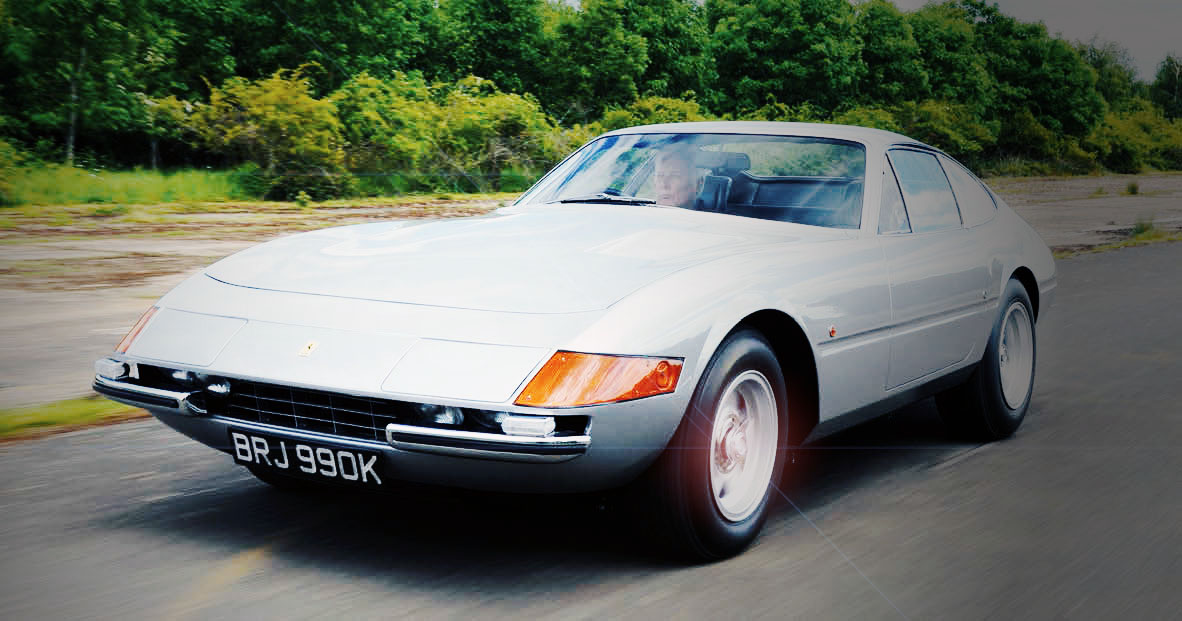
The first production models featured a full width Plexiglass strip behind which was mounted a twin headlight assembly at each side, running into the wing sides with the side/turn indicator units. In 1971 this lighting arrangement was superseded by a twin retractable headlight arrangement, as changes in USA legislation did not permit headlights behind covers.
Almost a year after its introduction a spider version, the 365 GTS4, was announced at the 1969 Frankfurt Salon, which was visually identical from the waist down, only the folding roof and boot profile being visually different. The spider version proved to be extremely popular, particularly in the American market, and from the time of its introduction accounted for about ten per cent of 365 GTB/4 model sales. Both variants of the model were produced up until 1973 which, by the standards of previous models, was a lengthy run. A total of 1284 berlinettas and 122 spiders were produced.
The bodies were mounted on a 2400mm wheelbase chassis and were numbered in the odd chassis number road car sequence. The engine was an increased capacity longer block derivation of the twin overhead camshaft per bank V12 unit used in the 275 GTB/4, with factory type reference 251, of 4390cc capacity, and like that engine featured dry sump lubrication. The engine drove through a flywheel mounted clutch and torque tube to a five speed transaxle, with drive shafts to the independently suspended rear wheels. The standard road wheels were five spoke ‘star’ pattern alloy, with the option of Borrani wire wheels.
Apart from the standard road cars, there were three series of five client competition examples built at the factory’s ‘Assistenza Clienti’ department in Modena, along with an earlier one off all aluminium bodied car for Luigi Chinetti’s North American Racing Team.
The first series of five competition examples, built in 1971, had all aluminium bodies. They featured slightly flared wheelarches with wider wheels, aerodynamic ‘fences’ on the front wings, a small chin spoiler, and a lack of quarter bumpers as the main identifying features. The second series, produced in early 1972, had steel bodies with the aluminium bonnet, boot lid, and doors of the road cars, but with much increased flares to the wheelarches to accommodate even wider wheels and tyres. The third series, produced in early 1973, were visually very similar to the series II cars, but had steel doors, with only the bonnet and boot lid in aluminium. They all received carefully built and balanced engines to racing standards, and some performance details were enhanced by the homologation of special parts over the period of production.
These competition examples proved to be very successful in the GT category, not only due to their power, but also reliability, in endurance events. At the Le Mans 24 Hour Race in 1972 all but one of them finished in top places, repeating the class wins there in 1973 and 1974. As late as 1979 they were still performing credibly, with a second overall in the Daytona 24 Hour Race, a great result for a car that had been out of production for six years.
Thanks to Carlos Monteverde, James Haithwaite, Lee Maxted-Page and Ian Barkaway for their generous help.





